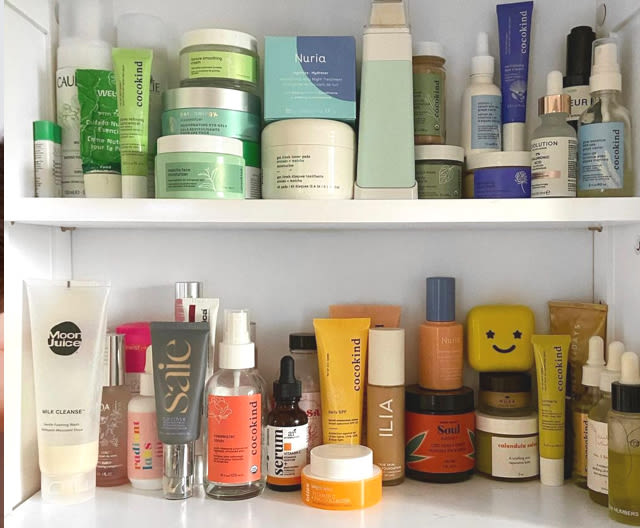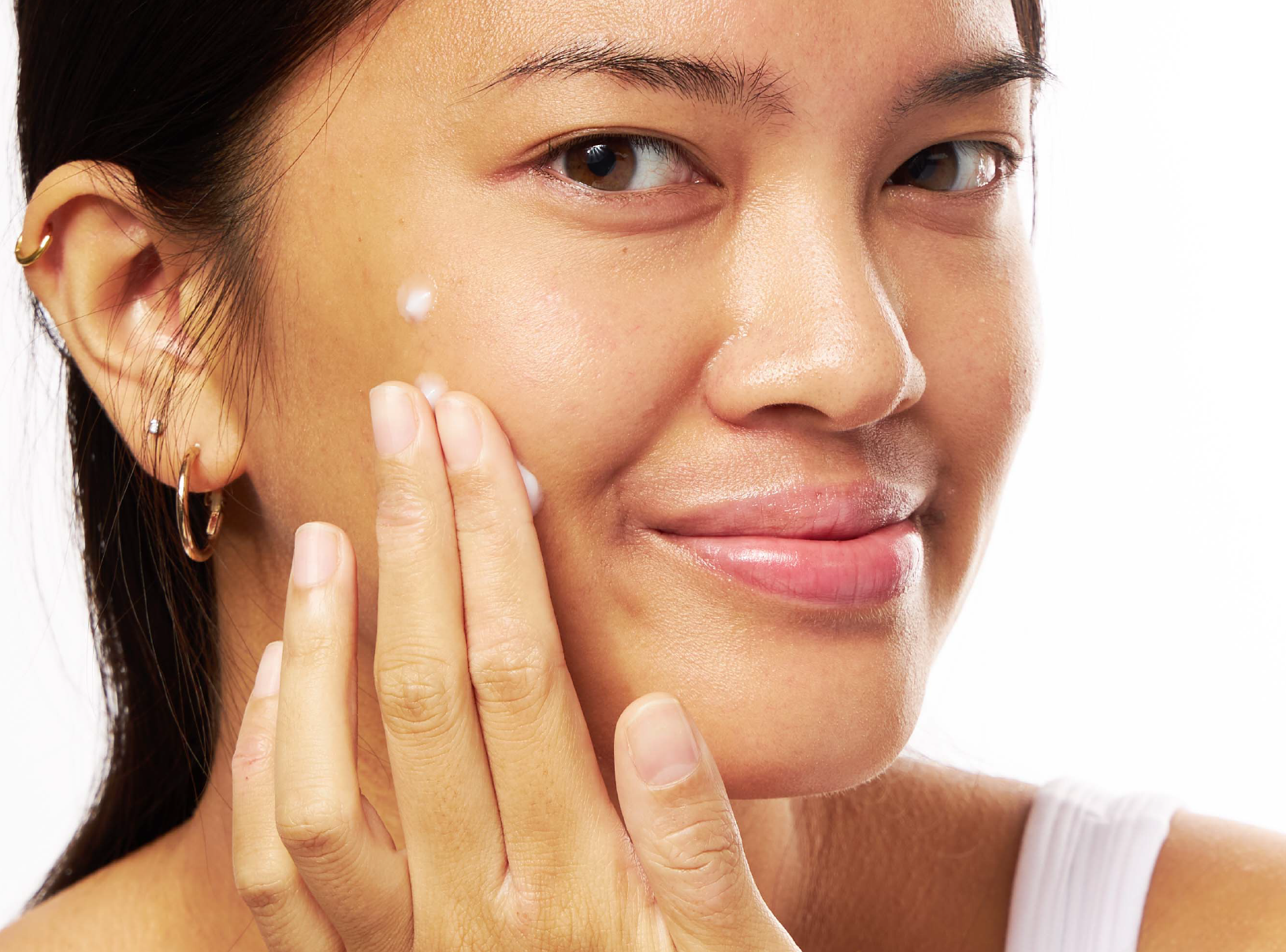Education
The best makeup for acne-prone skin


SHARE
Education
The best makeup for acne-prone skin
Medically reviewed by Katelyn Hagerty FNP
Written by Apostrophe Team
Last updated 4/1/2024
Cosmetics are an important part of skincare routines for one major reason: confidence. It’s about control over the version of yourself that you present to others, and feeling comfortable in your own skin, literally.
Unfortunately, makeup’s benefits can come at a price: The same things that can make you happy with your appearance can also damage it by causing acne.
We’re not saying all makeup is bad for your skin—far from it—but there are types of makeup that can be especially good at making breakouts happen. That makes the products especially bad for your end goals.
Here’s the lowdown on acne—and ingredients to avoid that could cause it, along with information on the best makeup for acne-prone skin.
What Is Acne?
Acne is essentially a bacterial infection in your pores that results from an imbalance in normal skin behavior.
There are four factors that can impact acne breakouts: oils, inflammation, bacteria, and dead cell disposal.
Essentially, pimples of all kinds occur when dead skin cells get stuck in your pores and your sebaceous glands produce oil (sebum) to help the cells slide out easily.
If there’s a clog in the pore, it can become a whitehead or blackhead, and if bacteria thrive in that clogged mess of cells and oil, it can cause inflammation and, well, pimples.
How Makeup Can Cause Acne
Makeup is great for disguising the occasional blemish, but in some cases, it can worsen skin over time.
If you’re covering your skin with something that can contribute to clogged pores, it’s likely going to cause acne.
But not all makeup is made equal.
Different ingredients can cause higher risks of acne, regardless of skin type. For instance, cosmetics containing certain oils can block pores, increasing the risk of breakouts.
According to the American Academy of Dermatology (AAD), there are habits that can increase your acne risk.
One of them is using makeup not designed to prevent acne.
Certain types of cosmetics are made from oils or other ingredients that can cause breakouts, and continued use may simply further blemish production.
Another habit the AAD advises against: sharing. While you and your besties may want to swap palettes from time to time, it’s advised to resist the urge. According to the AAD, sharing makeup can mean swapping bacteria from others’ skin—which can lead to breakouts. Transferring dead skin and oils can also clog pores.
This may be obvious, but sleeping in your makeup is another big no-no. The AAD advises cleansing your face to remove dirt and makeup before hitting the sack.
If you’re tired or short on time, wiping your face with a cleansing towelette before sleep can help.
It’s interesting to note that creating or finding the best makeup for acne-prone skin isn’t a new concept.
There have been generational studies about makeup ingredients, and which ones can make acne worse.
A 1976 study addressed the search for a “comedogenic-free” cosmetic for acne-prone skin, which led to testing and determining which ingredients at the time were causing acne.
According to the study researchers, some lanolin modifications made the ingredients comedogenic (pore clogging), along with emulsifiers like sodium lauryl sulfate, butyl stearate, and isopropyl myristate.
Researchers conducting a later study found further comedogenic potential with the use of oils like lanolins, along with certain types of dyes.
Among the most troublesome: D & C Red dyes, which are often found in blush.
Types of Makeup Best For Acne Prone Skin
If there was one proven type of makeup that did not cause acne, chances are that most cosmetics would reflect those standards these days.
Unfortunately, we’re still learning about what does and doesn’t work.
The best types of makeup, for the most part, are the ones made without ingredients that have been shown to cause or worsen acne.
Products made without offending ingredients are commonly referred to as “non-comedogenic”—literally makeup that doesn’t cause comedones (build-up in the pores).
For this reason, the AAD suggests looking for cosmetics labeled “non-comedogenic” because the products likely won’t directly cause acne.
Makeup Ingredients to Look For
The cosmetics world is constantly developing new treatments and exploring research, but for the time being, here’s what you should look for in makeup for acne-prone skin:
Products that might do double-duty and contain ingredients like benzoyl peroxide or azelaic/salicylic acid/triclosan. These ingredients help kill bacteria, unclog pores, and remove dead skin.
Sebum (oil) control products that contain niacinamide or zinc acetate/salicylic acid. It can work as a clarifying agent on its own, as it may prevent and reduce acne.
Antimicrobial and anti-inflammatory ingredients including ethyl lactate, phytosphingosine niacinamide, or resveratrol, which can help keep skin clear and calm.
Comedolytic or anti-comedogenic ingredients like corneolytics (peels), which you may find in some types of foundation or BB creams.
There’s a caveat to all of the above ingredients, however, because your skin’s needs are so individualized.
You will likely have to use trial and error to find the right ingredients for you, and/or seek the advice of a healthcare professional.
For example, greasy cosmetics may block pores for most folks, but your skin may tolerate these types of products well, and respond more negatively to drying ingredients.
The Best Makeup for Your Acne-Prone Skin
If you’re an acne sufferer, you don’t have to quit wearing makeup. That said, it might be time to take a closer look at the ingredients in your favorite products and avoid what you can.
Essentially, read your labels.
Mineral makeup can be a good option for those with acne-prone or sensitive skin as it’s often made without preservatives and harsh ingredients.
As for the best mineral makeup for acne-prone skin: You’ll still want to look for “non-comedogenic” on the packaging, to make sure the product won’t clog your pores.
If your acne is severe, consider speaking with a healthcare professional.
He or she will be able to give you more insight into what may or may not be causing your acne, along with types of cosmetic ingredients that may be helpful.
For more information on the connection between acne and makeup, or for ways to simply score a clearer complexion, check out this "Fact or Fiction: Acne and Makeup" article and start an online consultation through Apostrophe today.
References:
Fulton, J. E., Jr, Pay, S. R., & Fulton, J. E., 3rd (1984). Comedogenicity of current therapeutic products, cosmetics, and ingredients in the rabbit ear. Journal of the American Academy of Dermatology, 10(1), 96–105. https://pubmed.ncbi.nlm.nih.gov/6229554/.
Yoham AL, Casadesus D. Tretinoin. [Updated 2020 Dec 5]. In: StatPearls [Internet]. Treasure Island (FL): StatPearls Publishing; 2021 Jan-.https://www.ncbi.nlm.nih.gov/books/NBK557478/.
Rodan, K., Fields, K., Majewski, G., & Falla, T. (2016). Skincare Bootcamp: The Evolving Role of Skincare. Plastic and reconstructive surgery. Global open, 4(12 Suppl Anatomy and Safety in Cosmetic Medicine: Cosmetic Bootcamp), e1152. https://www.ncbi.nlm.nih.gov/pmc/articles/PMC5172479/.
American Academy of Dermatology Association. (n.d.). CAN THE RIGHT DIET GET RID OF ACNE? Retrieved March 5, 2021, from https://www.aad.org/public/diseases/acne/causes/diet.
Jegasothy, S. M., Zabolotniaia, V., & Bielfeldt, S. (2014). Efficacy of a New Topical Nano-hyaluronic Acid in Humans. The Journal of clinical and aesthetic dermatology, 7(3), 27–29. https://www.ncbi.nlm.nih.gov/pmc/articles/PMC3970829/.
Hoover E, Aslam S, Krishnamurthy K. Physiology, Sebaceous Glands. [Updated 2020 Oct 26]. In: StatPearls [Internet]. Treasure Island (FL): StatPearls Publishing; 2021 Jan-. https://www.ncbi.nlm.nih.gov/books/NBK499819/.
10 skin Care habits that can WORSEN acne. (n.d.). Retrieved May 11, 2021, from https://www.aad.org/public/diseases/acne/skin-care/habits-stop.
Acne. (n.d.). Retrieved January 28, 2021, from https://www.hopkinsmedicine.org/health/conditions-and-diseases/acne.
Dalloglio, F., Tedeschi, A., Fabbrocini, G., Veraldi, S., Picardo, M., & Micali, G. (2015). Cosmetics for acne: indications and recommendations for an evidence-based approach. Giornale italiano di dermatologia e venereologia : organo ufficiale, Societa italiana di dermatologia e sifilografia, 150(1), 1–11. https://pubmed.ncbi.nlm.nih.gov/25315288/.
InformedHealth.org [Internet]. Cologne, Germany: Institute for Quality and Efficiency in Health Care (IQWiG); 2006-. Skin care for acne-prone skin. 2013 Jan 16 [Updated 2019 Sep 26]. Available from: https://www.ncbi.nlm.nih.gov/books/NBK279208/
Like what you just read? Sign up for our email list to get the scoop on skincare science delivered straight to your inbox.

Education
What is milia?
What is milia? Today, we’re jumping into one type of bump that you may have heard about most commonly in infants — milia.
Read More
Education
Best moisturizer for acne-prone skin
If you have combination acne-prone skin, figuring out which moisturizer is best for your skin might be tough. In this guide, we break down the best moisturizer for combination, acne-prone skin.
Read More
Education
How to build a face care routine
As you get into skincare, it might seem overwhelming, especially trying to figure out the order you're supposed to apply products in. Below, we detail how to build a face care routine for your skin!
Read More
